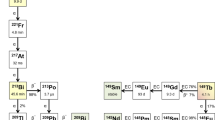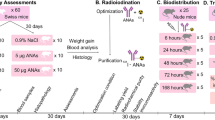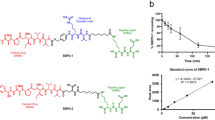Abstract
Limited options for the treatment of prostate cancer have spurred the search for new therapies. One innovative approach is the use of targeted alpha therapy (TAT) to inhibit cancer growth, using an alpha particle emitting radioisotope such as 213Bi. Because of its short range and high linear energy transfer (LET), α-particles may be particularly effective in the treatment of cancer, especially in inhibiting the development of metastatic tumors from micro-metastases. Prostate-specific membrane antigen (PSMA) is expressed in prostate cancer cells and the neovasculature of a wide variety of malignant neoplasms including lung, colon, breast and others, but not in normal vascular endothelium. The expression is further increased in higher-grade cancers, metastatic disease and hormone-refractory prostate cancer (PCA). J591 is one of several monoclonal antibodies (mabs) to the extracellular domain of PSMA. Chelation of J591 mab with 213Bi forms the alpha-radioimmunoconjugate (AIC). The objective of this preclinical study was to design an injectable AIC to treat human prostate tumors growing subcutaneously in mice. The anti-proliferative effects of AIC against prostate cancer were tested in vitro using the MTS assay and in vivo with the nude mice model. Apoptosis was documented using terminal deoxynucleotidyl transferase [TdT]-mediated deoxyuridinetriphosphate [dUTP] nick end-labeling (TUNEL) assay, while proliferative index was assessed using the Ki-67 marker. We show that a very high density of PSMA is expressed in an androgen-dependent human PCA cell line (LNCaP-LN3) and in tumor xenografts from nude mice. We also demonstrate that the AIC extensively inhibits the growth of LN3 cells in vitro in a concentration-dependent fashion, causing the cells to undergo apoptosis. Our in vivo studies showed that a local AIC injection of 50 μCi at 2 days post-cell inoculation gave complete inhibition of tumor growth, whereas results for a non-specific AIC were similar to those for untreated mice. Further, after 1 and 3 weeks post-tumor appearance, a single (100 μCi/100 μl) intra-lesional injection of AIC can inhibit the growth of LN3 tumor xenografts (volume<100 mm3) in nude mice. Tumors treated with AIC decreased in volume from a mean 46±14 mm3 in the first week or 71±15 mm3 in the third week to non-palpable, while in control mice treated with a non-specific AIC using the same dose, tumor volume increased from 42 to 590 mm3. There were no observed side effects of the treatment. Because of its in vitro cytotoxicity and these anti-proliferative properties in vivo, the 213Bi-J591 conjugate has considerable potential as a new therapeutic agent for the treatment of prostate cancer.
This is a preview of subscription content, access via your institution
Access options
Subscribe to this journal
Receive 4 print issues and online access
$259.00 per year
only $64.75 per issue
Buy this article
- Purchase on Springer Link
- Instant access to full article PDF
Prices may be subject to local taxes which are calculated during checkout





Similar content being viewed by others
References
Landis SH, Murray T, Bolden S, Wingo PA. . Cancer statistics. CA, Cancer J Clin 1998 48: 6–29.
Fowler JE Jr, Braswell NT, Pandey P, Seaver L. . Experience with radical prostatectomy and radiation therapy for localized prostate cancer at a Veterans Affairs Medical Center. J Urol 1995 153: 1026–1031.
Wasson JH et al.. A structural literature review of treatment for localized prostate cancer. Prostate Disease Patient Outcome Research Team. Arch Family Med 1993 2: 487–493.
Litwin MS et al.. Epidemiological trends and financial outcomes in radical prostatectomy among Medicare beneficiaries, 1991 to 1993. J Urol 1998 160: 445–448.
Lepor H, Ross A, Walsh PC. . The influence of hormonal therapy on survival of men with advanced prostatic cancer. J Urol 1982 128: 335–340.
Blake GM, Zivanovic MA, McEwan AJ, Ackery DM. . Sr-89 therapy: strontium kinetics in disseminated carcinoma of the prostate. Eur J Nucl Med 1986 12: 447–454.
Allen BJ, Blagojevic N. . Alpha- and beta-emitting radiolanthanides in targeted cancer therapy: the potential role of terbium-149. Nuclear Med Comm 1996 17: 40–47.
Vaughan AT, Bateman WJ, Brown G, Cowan J. . The specific inhibition of cellular clonogenic proliferation using 211At labeled lectins and antibodies-1. Int J Nucl Med Biol 1982 9: 167–171.
Goddu SM, Howell RW, Rao DV. . Cellular dosimetry: absorbed fractions for monoenergetic electron and alpha particle sources and S-values for radionuclides uniformly distributed in different cell compartments. J Nucl Med 1994 35: 303–316.
Humm JL. . A microdosimetric model of astatine-211 labeled antibodies for radioimmunotherapy. Int J Radiat Oncol Biol Phys 1987 13: 1767–1773.
Bloomer WD et al.. 211At radiocolloid therapy: further observations and comparison with radiocolloids of 32P, 165Dy, 90Y. Int J Radiat Oncol Biol Phys 1984 10: 341–348.
Macklis RM et al.. Radioimmunotherapy with alpha-particle-emitting immunoconjugates. Science 1988 240: 1024–1026.
Larsen RH, Akabani G, Welsh P, Zalutsky MR. . The cytotoxicity and microdosimetry of astatine-211-labeled chimeric monoclonal antibodies in human glioma and melanoma cells in vitro. Radiation Res 1998 149: 155–162.
Israeli RS et al.. Expression of the prostate-specific membrane antigen. Cancer Res 1994 54: 1807–1811.
Wright GL Jr et al.. Up-regulation of prostate-specific membrane antigen after androgen-deprivation therapy. Urology 1996 48: 326–334.
Silver DA et al.. Prostate-specific membrane antigen expression in normal and maligant human tissues. Clin Cancer Res 1997 3: 81–85.
Liu H et al.. Monoclonal antibodies to the extracellular domain of prostate-specific membrane antigen also react with tumour vascular endothelium. Cancer Res 1997 57: 3629–3634.
Liu H et al.. Constitutive and antibody-induced internalization of prostate-specific membrane antigen. Cancer Res 1998 58: 4055–4060.
Royai R, Lange PH, Vessella R. . Preclinical models of prostate cancer. Semin Oncol 1996 23: 35–40.
Stone KR et al.. Isolation of a human prostate carcinoma cell line (DU 145). Int J Cancer 1978 21: 274–281.
Kaighn ME et al.. Establishment and characterization of a human prostatic carcinoma cell line (PC-3). Invest Urol 1979 17: 16–23.
Horoszewicz JS et al.. LNCaP model of human prostatic carcinoma. Cancer Res 1983 43: 1809–1818.
Pettaway CA et al.. Selection of highly metastatic variants of different human prostatic carcinomas using orthopotic implantation in nude mice. Clin Cancer Res 1996 2: 1627–1636.
Montgomery BT et al.. Hormonal regulation of prostate-specific antigen (PSA) glycoprotein in the human prostatic adenocarcinoma cell line, LNCaP. Prostate 1992 21: 63–73.
Veldscholte J et al.. A mutation in the ligand binding domain of the androgen receptor of human LNCaP cells affects steroid binding characteristics and response to anti-androgens. Biochem Biophys Res Commun 1990 173: 534–540.
Allen BJ. . Targeted alpha therapy: evidence for potential efficacy of alpha-immunoconjugates in the management of micrometastatic cancer. Australasian Radiology 2000 43: 480–486.
Rizvi SMA, Sarkar S, Goozee G, Allen BJ. . Radio-immunoconjugates for targeted alpha therapy of malignant melanoma. Melanoma Res 2000 10: 281–289.
Allen BJ, Rizvi SMA, Tian Z. . Preclinical targeted alpha therapy for melanoma. Melanoma Res 2001 8: 1–8.
Rizvi SMA, Henniker AJ, Goozee G, Allen BJ. . In vitro testing of the leukaemia monoclonal antibody WM-53 labeled with alpha and beta emitting radioisotopes. Leukaemia Research, in press.
Rizvi SMA et al. In vitro and preclinical studies of targeted alpha therapy for colorectal cancer. Colorectal Disease 2001 3: 345–353.
Allen BJ, Rizvi SMA, Li Y, Tian Z, Ranson M. . In vitro and preclinical targeted alpha therapy for melanoma, breast, prostate and colorectal cancers. Critical Rev Oncology/Haematology 2001 39: 139–146
McDevitt MR et al. An α-particle emitter antibody ([213Bi]J591 for radioimmunotherapy of prostate cancer. Cancer Res 2000 60: 6095–6100.
Mosmann T. . Rapid colorimetric assay for cellular growth and survival: application to proliferation and cytotoxicity assays. J Immunol Methods 1983 65: 55–63.
Gavrieli Y, Sherman Y, Ben-Sasson SA. . Identification of programmed cell death in situ via specific labeling of nuclear DNA fragmentation. J Cell Biol 1992 119: 493–501.
Negoescu A et al.. In situ apoptotic cell labeling by the TUNEL method: improvement and evaluation on cell preparation. J Histo Cyto 1996 44: 959–968.
Lim DJ et al.. Growth of an androgen-sensitive human prostate cancer cell line, LNCaP, in nude mice. Prostate 1993 22: 109–118.
Kleinman HK et al.. Role of basement membrane and laminin in metastases and tumour growth. Proc Am Assoc Cancer Res 1990 31: 490–491.
Gleave M et al.. Acceleration of human prostate cancer growth in vivo by factors produced by prostate and bone fibroblasts. Cancer Res 1991 51: 3753–3761.
Kerr JF, Wyllie AH, Currie AR. . Apoptosis: a basic biological phenomenon with wide-ranging implications in tissue kinetics. Br J Cancer 1972 26: 239–257.
Jurcic JG et al.. Phase 1 trial of targeted α-particle therapy for myeloid leukaemias with bismuth-213-HuM195 (anti-CD33). Proc Am Soc Clin Oncol 1999 18: 7a.
Hartmann F et al.. Radioimmunotherapy of nude mice bearing a human interleukin 2 receptor alpha-expressing lymphoma utilizing the alpha-emitting radionuclide-conjugated monoclonal antibody 212Bi-anti-Tac. Cancer Res 1994 54: 4362–4370.
Gerdes J, Schwab U, Lemke H, Stein H. . Production of a mouse monoclonal antibody reactive with a human nuclear antigen associated with cell proliferation. Int J Cancer 1983 31: 13–20.
Zalutsky MR, Bigner DD. . Radioimmunotherapy with alpha-particle-emitting radioimmunoconjugates. Acta Oncol 1996 35: 373–379.
Vaidyanathan G, Zalutsky MR. . Targeted therapy using alpha emitters. Phys Med Biol 1996 41: 1915–1931.
McDevitt MR et al.. Radioimmunotherapy with alpha-emitting nuclides. Eur J Nuclear Med 1998 25: 1341–1351.
Huneke RB et al.. Effective alpha-particle-mediated radioimmunotherapy of murine leukemia. Cancer Res 1992 52: 5818–5820.
Zalutsky MR et al.. Radioimmunotherapy of neoplastic meningitis in rats using an α-particle-emitting immunoconjugate. Cancer Res 1994 54: 4719–4725.
Kennel SJ et al.. Radioimmunotherapy of micrometastases in lung with vascular targeted 213Bi. Br J Cancer 1999 80: 175–184.
Rosenstraus MJ et al.. In vitro and in vivo reactivity of anti-prostate monoclonal antibody immunoconjugate 7E11.C5.3-GYK-DTPA. Antibody Immunoconjugates Radiopharm 1990 3: 54.
Lopes AD et al. Immunohistochemical and pharmacokinetic characterization of the site-specific immunoconjugate CYT-356 derived from antiprostate monoclonal antibody 7E11-C5. Cancer Res 1990 50: 6423–6429.
Kawakami M, Nakayama J. . Enhanced expression of prostate-specific membrane antigen gene in prostate cancer as revealed by in situ hybridization. Cancer Res 1997 57: 2321–2324.
Chang SS et al. Five different anti-prostate-specific membrane antigen (PSMA) antibodies confirm PSMA expression in tumour-associated neovasculature. Cancer Res 1999 59: 3192–3198.
Wynant GE et al. Immunoscintigraphy of prostatic cancer: preliminary results with 111In-labeled monoclonal antibody 7E11-C5.3 (CYT-356). Prostate 1991 18: 229–241.
Murphy G et al. Phase I clinical trial: T-cell therapy for prostate cancer using autologous dendritic cells pulsed with HLA-A0201-specific peptides from prostate-specific membrane antigen. Prostate 1996 29: 371–380.
Tjoa BA et al. Follow-up evaluation of prostate cancer patients infused with autologous dendritic cells pulsed with PSMA peptides. Prostate 1997 32: 272–278.
Fisher DE. . Apoptosis in cancer therapy: crossing the threshold. Cell 1994 78: 539–542.
Yonish-Rouach E et al.. Wild-type p53 induces apoptosis of myeloid leukemic cells that is inhibited by interleukin-6. Nature 1991 352: 345–347.
Symonds H et al.. p53-Dependent apoptosis suppresses tumour growth and progression in vivo. Cell 1994 78: 703–711.
Radford IR. . Evidence for a general relationship between the induced level of DNA double-strand breakage and cell-killing after x-irradiation of mammalian cells. Int J Radiat Biol 1986 49: 611–620.
Ward JF. . DNA damage produced by ionizing radiation in mammalian cells: identities, mechanisms of information, reparability. Prog Nucleic Acid Mol Biol 1988 35: 95–125.
Bradford JS. . Sublethal damage, potentially lethal damage, and chromosomal aberrations in mammalian cells exposed to ionizing radiation. Int J Radiat Oncol Biol Phys 1991 21: 1457–1469.
Warters RL. . Radiation-induced apoptosis in a murine T-cell hybridoma. Cancer Res 1992 52: 883–890.
Payne CM, Bjore CG Jr, Schultz DA. . Change in the frequency of apoptosis after low- and high-dose X-irradiation of human lymphocytes. J Leukocyte Biol 1992 52: 433–440.
Kimura K, Bowen C, Spiegel S, Gelmann EP. . Tumour necrosis factor-alpha sensitizes prostate cancer cells to gamma-irradiation-induced apoptosis. Cancer Res 1999 59: 1606–1614.
Nava VE et al.. Sphingosine enhances apoptosis of radiation-resistant prostate cancer cells. Cancer Res 2000 60: 4468–4474.
Acknowledgements
The authors wish to acknowledge the ongoing support given by Professor J Kearsley, Director, Cancer Services Division. We also thank Professor Pamela J Russell, for kindly providing LNCap-LN3 prostate cancer cell line with the permission of Dr C Pettaway, MD Anderson Hospital, Professor P Hersey, Royal Newcastle Hospital for providing the non-specific melanoma antibody. This project was supported in part by a grant from the Kogarah-Carlton Masonic Lodge.
Author information
Authors and Affiliations
Corresponding author
Rights and permissions
About this article
Cite this article
Li, Y., Tian, Z., Rizvi, S. et al. In vitro and preclinical targeted alpha therapy of human prostate cancer with Bi-213 labeled J591 antibody against the prostate specific membrane antigen. Prostate Cancer Prostatic Dis 5, 36–46 (2002). https://doi.org/10.1038/sj.pcan.4500543
Received:
Accepted:
Published:
Issue Date:
DOI: https://doi.org/10.1038/sj.pcan.4500543
Keywords
This article is cited by
-
Nanoparticle orientation to control RNA loading and ligand display on extracellular vesicles for cancer regression
Nature Nanotechnology (2018)
-
Targeted alpha therapy of mCRPC: Dosimetry estimate of 213Bismuth-PSMA-617
European Journal of Nuclear Medicine and Molecular Imaging (2018)
-
Extraction chromatographic behavior of actinium and REE on DGA, Ln and TRU resins in nitric acid solutions
Journal of Radioanalytical and Nuclear Chemistry (2015)
-
Biodistribution of 212Pb conjugated trastuzumab in mice
Journal of Radioanalytical and Nuclear Chemistry (2013)
-
Lentivirus-mediated RNAi knockdown of prostate-specific membrane antigen suppresses growth, reduces migration ability and the invasiveness of prostate cancer cells
Medical Oncology (2011)



